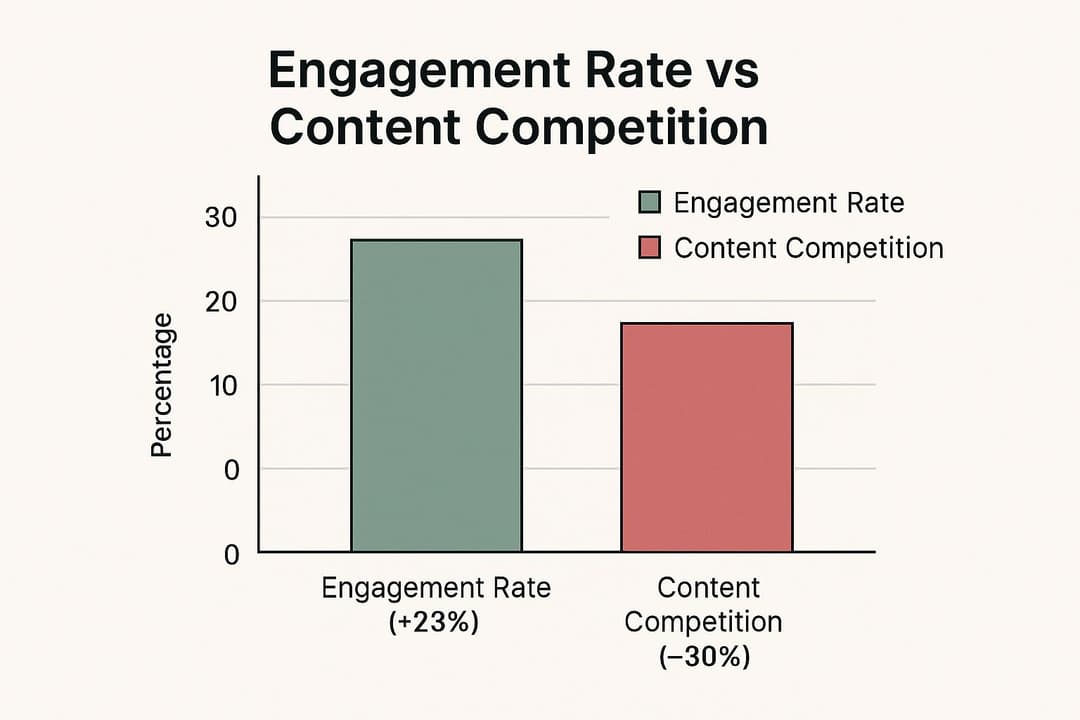Are you creating amazing content only to have it disappear into the void? The problem might not be your content, but your timing. Posting at the wrong time on Facebook means your message gets buried before your audience even logs on. In a world of ever-changing algorithms, understanding the when is just as crucial as the what.
This guide moves beyond generic advice to provide a data-backed breakdown of the best times and days to post on Facebook. We will explore specific, actionable windows for maximum impact, from peak weekday hours to ideal weekend slots. While these tips are a fantastic starting point for Facebook, a holistic strategy requires a wider view. For a broader perspective on optimal timing across various platforms, you can explore general insights on the best times to post on social media.
Our focus here is singular: to help you stop guessing and start scheduling with precision. We'll cover the golden hours for engagement, the most effective days of the week, and how to use Facebook's own tools to tailor these insights to your unique audience. Get ready to ensure your posts finally get the visibility and engagement they deserve.
1. Post Between 1 PM and 3 PM on Weekdays for Peak Engagement
The early afternoon window between 1 PM and 3 PM on weekdays represents a golden hour for Facebook engagement. This is often when people take their lunch break or experience a mid-afternoon lull at work, leading them to scroll through their social media feeds. Unlike the highly saturated evening hours, this timeframe offers a strategic advantage: lower competition combined with a focused, active audience.
During this period, users are looking for a quick mental break and are more receptive to engaging content before diving back into their work. This makes it one of the best times and days to post on Facebook for brands aiming to capture immediate attention and interaction.
Why This Time Window Works
The success of this strategy hinges on user behavior. The 1 PM to 3 PM slot aligns perfectly with the natural rhythm of the workday for many professionals.
- B2C Brands: A local restaurant can post a lunch special at 1 PM to drive immediate foot traffic. A retail store can share a flash sale to catch shoppers on their break.
- B2B Companies: Businesses like Salesforce have found success sharing professional articles, case studies, or webinar announcements during this window, catching their target audience when they are still in a work-oriented mindset but open to a brief distraction.
HubSpot famously reported a 23% increase in engagement when posting at 1 PM compared to their morning posts, highlighting the power of precise timing. The following chart visualizes the dual benefit of posting in the early afternoon: higher engagement potential and lower content competition.
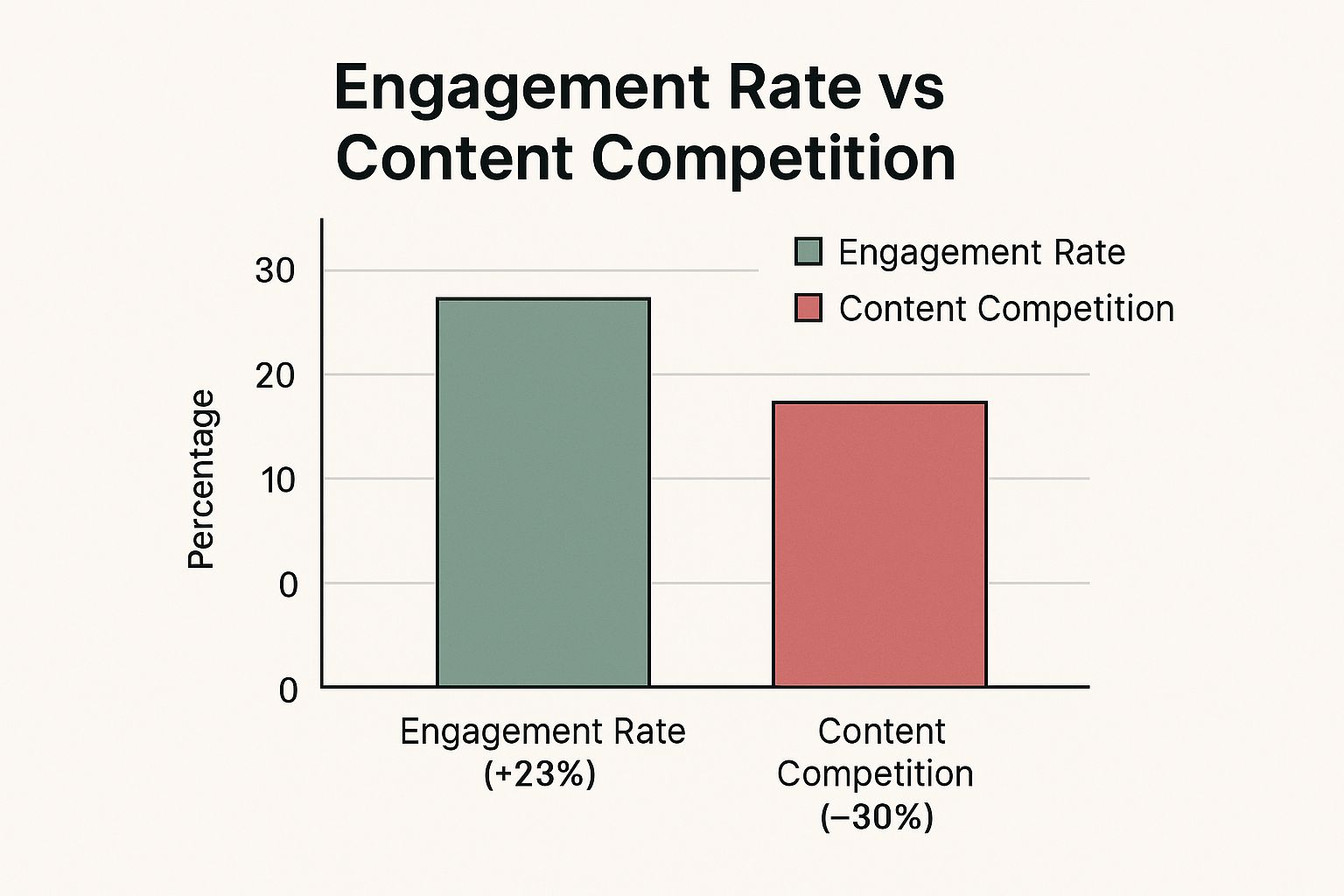
This bar chart clearly shows that the early afternoon offers a powerful combination, allowing your content to stand out while reaching a more engaged audience.
Actionable Tips for Implementation
To make the most of this peak time, follow these specific steps:
- Test and Measure: Don't just post at 1 PM every day. Experiment by scheduling content at 1 PM, 2 PM, and 3 PM on different weekdays. Use Facebook Insights to see which specific hour drives the most clicks, comments, and shares for your audience.
- Consider Time Zones: If your audience is spread across different regions, target the 1-3 PM window in their primary time zone. For a national audience, you might test posts based on a central time zone like EST or CST.
- Schedule Consistently: Use a scheduling tool to ensure your posts go live consistently during this window. Consistency helps your audience learn when to expect new content from you.
By aligning your posting schedule with this natural lull in the workday, you can significantly boost your content's visibility and interaction rates. For a deeper analysis of daily user activity, you can explore the best time of day to post on Facebook for more detailed insights.
2. Tuesday Through Thursday for Maximum Weekday Reach
While specific times matter, the day of the week you post is equally crucial. The mid-week period from Tuesday through Thursday consistently emerges as a high-performance zone for Facebook content. This timeframe avoids the "catching up" chaos of Monday and the "winding down" disengagement of Friday, placing your posts directly in front of an audience that has settled into its weekly routine and is more actively scrolling.
During these days, users are in a predictable rhythm of work and breaks, making them more receptive to content. This makes Tuesday, Wednesday, and Thursday some of the best times and days to post on Facebook for achieving sustained visibility and interaction throughout the workweek.
Why These Days Work
The effectiveness of this mid-week strategy is rooted in established user habits. People are past the Monday morning rush and not yet checked out for the weekend, creating a peak period of online activity.
- B2C Brands: Nike has often leveraged this window for successful mid-week product launches, generating significant shares and buzz when their audience is most attentive.
- Media Organizations: News outlets like the BBC consistently see their highest engagement rates on stories published between Tuesday and Thursday, as people are actively seeking information and updates.
- B2B Companies: Sprout Social's research famously highlighted that engagement is often highest mid-week, with Wednesdays showing an 18% lift compared to other days.
Focusing your content calendar on these days capitalizes on when your audience is most likely to be online and in a mindset to consume and interact with brand content.
Actionable Tips for Implementation
To harness the power of the mid-week peak, follow these specific steps:
- Prioritize Key Content: Schedule your most important announcements, product launches, or high-value blog posts for Tuesday or Wednesday to maximize their initial reach.
- Use Thursday for Community Building: Dedicate Thursdays to more interactive content like polls, questions, or behind-the-scenes posts to foster conversation and engagement leading into the weekend.
- Confirm with Your Insights: While this pattern is common, always use Facebook Insights to verify it holds true for your specific audience. Check which days consistently deliver your best results.
- Plan Your Calendar Accordingly: Build your monthly content calendar around this mid-week peak. Front-load your best content on these days and use Mondays and Fridays for lighter, supporting posts.
Strategically timing your posts for these days is a powerful way to improve performance. For a broader look at daily trends, you can explore the best days to post on social media for more detailed analysis.
3. Wednesday at 11 AM – The Golden Hour for Facebook Posting
If there's one specific time slot to circle on your content calendar, it's Wednesday at 11 AM. This period is widely regarded as the single most effective time for Facebook posting across a multitude of industries. It represents the perfect storm of user activity: it's mid-week, so the initial rush of Monday and Tuesday has settled, and it's late morning, when people often take a brief screen break before lunch.
This timing captures a highly engaged audience when they are receptive to new content but not yet distracted by their lunch plans. For brands looking for the most reliable performance, this slot consistently delivers, making it one of the best times and days to post on Facebook for high-impact announcements and key messages.
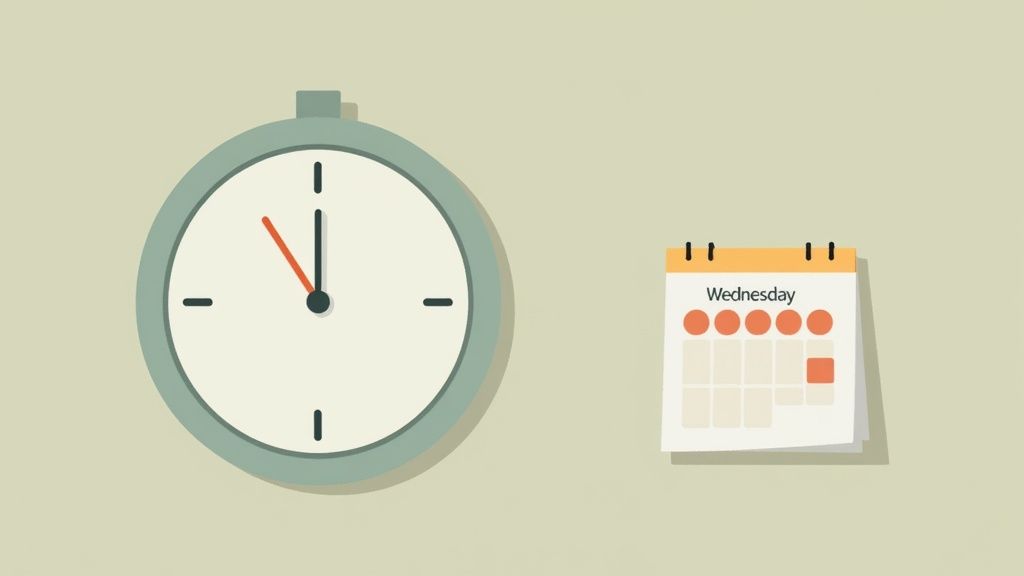
Why This Time Window Works
The effectiveness of Wednesday at 11 AM is backed by extensive data and rooted in predictable human behavior. By mid-week, users have caught up on their work and are more likely to browse social media.
- B2C Brands: Starbucks often sees its highest reach with promotions shared during this mid-morning window, catching people as they plan their coffee run.
- B2B Companies: CoSchedule’s research, spanning over 20 industries, repeatedly confirms Wednesday at 11 AM as a peak time. Sharing an industry report or a new case study at this time can capture professionals at their desks.
Social media management platform Buffer famously reported that their posts at 11 AM on Wednesdays received 25% more engagement than at other times. This data highlights just how powerful hitting this precise "golden hour" can be for maximizing content visibility and interaction.
Actionable Tips for Implementation
To capitalize on this well-documented peak time, integrate the following strategies into your workflow:
- Prioritize Key Content: Reserve this prime slot for your most important content, such as major announcements, product launches, or flagship blog posts.
- A/B Test Adjacent Times: While 11 AM is the benchmark, test posts at 10 AM and 12 PM to see if a slightly different time works better for your specific audience. Your sweet spot might be just before or after the main rush.
- Confirm Time Zones: Ensure you are scheduling for 11 AM in the primary time zone of your target audience. Use your Facebook Insights to identify where the majority of your followers are located.
- Schedule for Consistency: Use a social media scheduler to lock in this time every Wednesday. This creates a predictable rhythm that can train your audience to look for your content.
4. Saturday and Sunday Morning for Lifestyle and Entertainment Content
Weekend mornings, particularly between 9 AM and 11 AM, open up a distinct opportunity for brands focused on lifestyle, entertainment, and personal interests. During this window, users are in a different mindset; they are browsing Facebook leisurely and are far more receptive to content that entertains, inspires, or adds value to their personal lives. This relaxed scrolling behavior creates an ideal environment for deeper engagement.
This timeframe is less about driving immediate business leads and more about building community and brand affinity. For businesses in the B2C space, understanding this shift is key to finding the best times and days to post on Facebook and connecting with audiences on a more personal level.
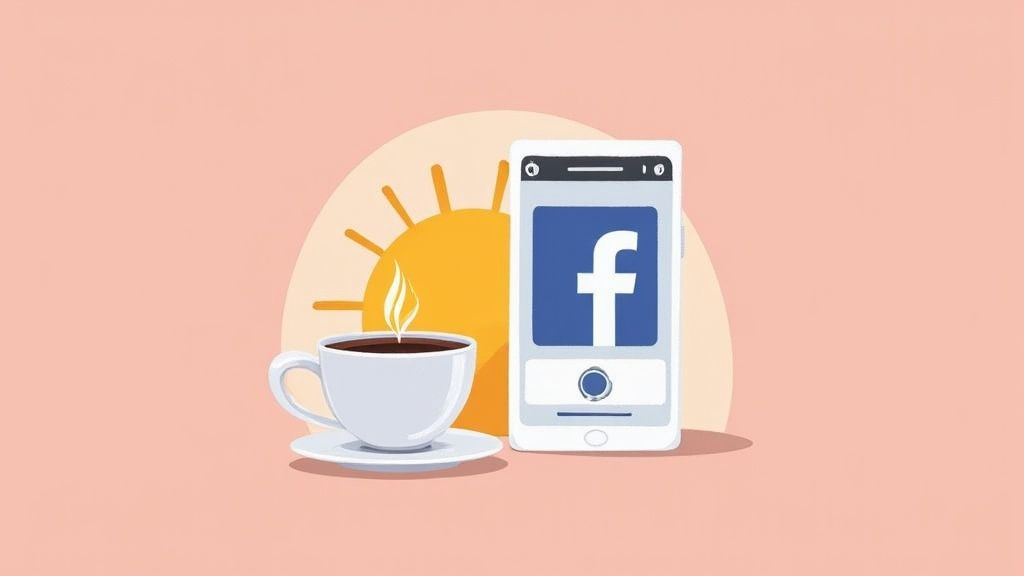
Why This Time Window Works
The effectiveness of weekend morning posts is rooted in a fundamental shift in user intent from professional to personal. People are planning their day, seeking relaxation, or looking for weekend inspiration.
- Lifestyle & Food Brands: Food Network famously discovered its video completion rates were 40% higher on weekend mornings. Users have more time to watch a full recipe video or plan a meal.
- Travel & Leisure: Travel bloggers often see peak engagement for destination guides and visually stunning travel photos on Saturday mornings as people daydream about their next getaway.
- Health & Fitness: Brands like Peloton successfully use this slot to motivate weekend workouts, sharing user-generated content or live class schedules to build a sense of community.
Actionable Tips for Implementation
To capitalize on the unique weekend morning audience, tailor your content strategy accordingly:
- Focus on Visuals: This is the perfect time for high-quality photos, carousels, and engaging videos. Think behind-the-scenes tours, stunning product shots, or inspiring user stories.
- Encourage Conversation: Ask questions that prompt personal responses, such as "What's your favorite weekend breakfast?" or "Where are you exploring today?". This builds a community-focused dialogue.
- Avoid the Hard Sell: Weekend mornings are not the time for aggressive, sales-heavy posts. Instead, aim for content that feels authentic, relatable, and less promotional to resonate with the relaxed weekend vibe.
5. Avoid Posting Between 8 PM and 9 AM – The Dead Zone
Just as important as knowing when to post is knowing when not to. The late evening through early morning, typically from 8 PM to 9 AM, represents a digital "dead zone" for Facebook engagement. During this extended window, most users are offline, either sleeping, commuting, or starting their workday with priorities far removed from social media.
Publishing content during this period is like shouting into an empty room. Your post gets buried in the feed overnight, and by the time your audience logs on in the morning, it's competing with a flood of newer content. Understanding this low-activity window is crucial for maximizing the reach of your posts and is a key part of finding the best times and days to post on Facebook.
Why This Time Window Fails
The logic behind avoiding the dead zone is rooted in simple user behavior and algorithm mechanics. Content published when few people are active struggles to gain the initial traction Facebook's algorithm needs to see before promoting it further.
- B2C Brands: A fashion retailer sharing a new collection at 11 PM will find its post has minimal likes and comments by morning, causing the algorithm to deprioritize it.
- Major Brands: Companies like Coca-Cola have learned through performance data that posts scheduled after 8 PM see a dramatic drop-off in engagement, leading them to concentrate their efforts during peak daytime hours.
Data from Sprout Social supports this, revealing that posts published after 8 PM can receive up to 42% less engagement compared to those shared during peak hours. This significant drop highlights the risk of wasting valuable content on an inactive audience.
Actionable Tips for Implementation
To steer clear of this engagement pitfall and protect your content's potential, implement these straightforward strategies:
- Schedule with Precision: Use a social media scheduling tool to queue your content for optimal times. This prevents accidental posts during the dead zone, especially if you're managing the page outside of standard business hours.
- Mind Your Time Zones: If you have a global audience, don't post at 10 PM in your local time if it's 7 AM for your target demographic. Calculate the peak hours for your most important audience segments and schedule accordingly.
- Prioritize Important Announcements: Never schedule critical updates, product launches, or major announcements during these off-peak hours. Save your most important content for windows when you know your audience is active and ready to engage.
By consciously avoiding this dead zone, you ensure your carefully crafted content gets the visibility and interaction it deserves when your audience is most receptive.
6. Use Your Page Insights to Find Audience-Specific Peak Times
While general industry data provides a great starting point, the ultimate source of truth for your brand lies within your own analytics. Facebook Page Insights offers a powerful, data-driven way to discover precisely when your unique audience is most active online, allowing you to move beyond averages and tailor your schedule for maximum impact. This approach replaces guesswork with concrete evidence from your followers' behavior.
Tapping into this data helps you identify patterns that are specific to your niche, location, and audience demographics. This makes it one of the most effective strategies to find the truly best times and days to post on Facebook for your page, as it is based on your actual followers, not broad industry benchmarks.
Why This Time Window Works
This strategy is effective because it's personalized. Every audience is different, and their online habits will reflect that. Page Insights reveals the specific hours and days your followers are scrolling, ensuring your content appears when they are most likely to see and engage with it.
- Local Gym: A fitness center might discover through Insights that its followers are most active at 6 AM before work and 7 PM after their evening workout, creating two perfect windows for posting class schedules or motivational content.
- B2B Software Company: A tech firm could find its professional audience peaks on Tuesdays at 2 PM, an ideal time to share industry articles or webinar invites, diverging from the typical consumer brand patterns.
- Restaurant Chain: Page Insights can reveal location-specific timing. A branch in a business district may see a lunchtime peak, while a suburban location might see higher activity during evening family hours.
This customized approach ensures you are not just posting at a "good" time, but at your best time.
Actionable Tips for Implementation
To leverage your Page Insights effectively, follow these specific steps:
- Review Insights Regularly: Check the "When Your Fans Are Online" tab in your Page Insights at least once a month. This will help you spot emerging trends or shifts in audience behavior.
- Cross-Reference with Post Performance: Don't just rely on the online activity chart. Compare it with the engagement data from your individual posts. Does posting during those peak hours actually lead to more likes, comments, and shares?
- Test and Confirm: Once you identify a potential peak window, test it consistently for 30 days. Schedule content specifically for those times and measure the results to confirm your hypothesis.
- Consider Seasonal Adjustments: Audience behavior can change with the seasons, holidays, or major events. Be prepared to adjust your posting schedule accordingly based on new data from your Insights.
7. Time Zone Considerations for Global Audiences
For businesses with an international or national audience spanning multiple time zones, a one-size-fits-all posting schedule simply won't work. Timing becomes complex as you must balance reaching different geographic regions effectively. The core strategy involves identifying your primary audience locations and either posting multiple times to cover peak hours in each zone or finding an overlap where several regions are active simultaneously.
This approach is critical for global brands aiming to maintain consistent engagement across their entire follower base. Understanding the best times and days to post on Facebook for each major segment ensures your content remains relevant and timely, regardless of where your audience lives.
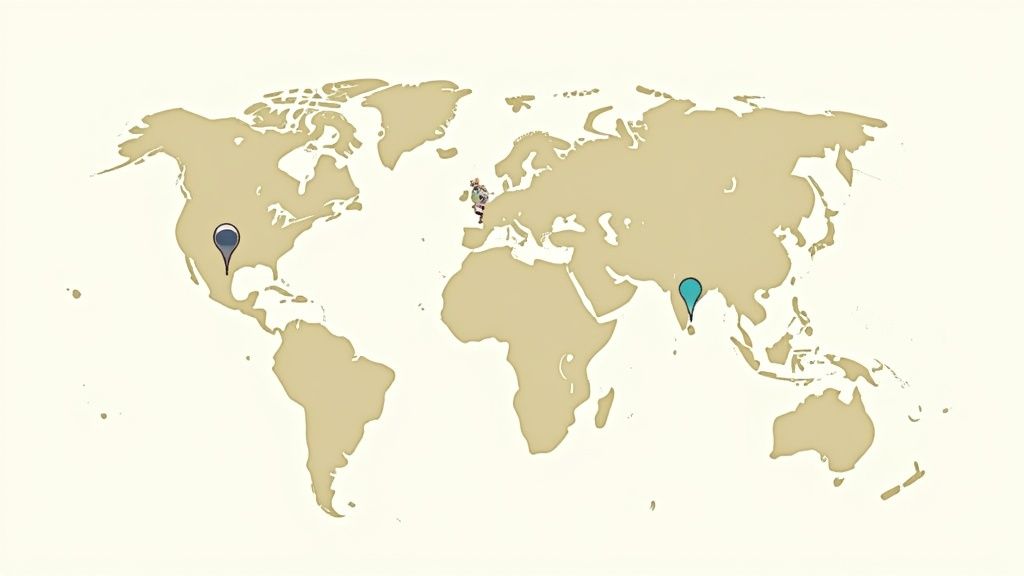
Why This Time Window Works
This strategy is built on the principle of meeting your audience where and when they are active. A single post at 2 PM EST will miss the morning scrollers in London and the evening audience in Sydney. By tailoring your schedule, you acknowledge and cater to these diverse behaviors.
- Global B2C Brands: McDonald's masters this by posting breakfast content tailored to local morning times across different regions. Similarly, Netflix promotes new shows during prime evening viewing hours specific to each country, maximizing relevance.
- International Service Providers: An international airline might post travel deals during the peak booking times for each region, such as late afternoon in Europe and then again for North America, ensuring the offers land when customers are most likely to act.
This targeted approach prevents your content from getting lost and demonstrates a deeper understanding of your global community’s habits. It allows a single brand to feel local and accessible to everyone.
Actionable Tips for Implementation
To effectively manage a multi-time-zone strategy, follow these steps:
- Identify Top Locations: Use Facebook Audience Insights to identify your top 3-5 geographic segments. Look at the data under "People" and then "Location" to see which cities and countries have the most followers.
- Schedule for Key Zones: Post 2-3 times per day to cover the peak engagement hours for your primary audience locations. For example, a post for Europe's afternoon, one for America's afternoon, and another for Asia's morning.
- Utilize Scheduling Tools: Leverage a social media scheduling tool that offers time zone features. This allows you to plan and automate posts for specific regions without having to post manually at odd hours.
- Analyze Segment Performance: Don't just post and forget. Use your analytics to track which posts perform best in which regions and refine your schedule accordingly.
By adopting a global mindset, you can significantly expand your reach and engagement. To learn more about how this applies across different platforms, you can find valuable insights in this guide on the best time to post on social media.
8. Friday Posts Should Focus on Weekend-Relevant Content
While Friday engagement can dip for serious, business-focused content, it opens a strategic opportunity for posts that align with the audience's weekend mindset. As the workweek concludes, users are mentally shifting gears, making them highly receptive to content related to leisure, entertainment, and upcoming plans. This makes Friday one of the best times and days to post on Facebook for brands that can tap into this pre-weekend excitement.
The key is to match your content's tone to the audience's mood. Instead of pushing hard sells or dense informational posts, focus on building community and providing value for their off-hours. This approach helps your brand stay relevant and connects with users on a more personal, relaxed level.
Why This Time Window Works
The effectiveness of this strategy is rooted in psychological timing. By Friday afternoon, users are less interested in work-related tasks and are actively planning or looking forward to their weekend.
- B2C Brands: A local movie theater can create buzz by posting its weekend showtime schedule. A restaurant can share a mouth-watering photo of its Saturday brunch special to encourage reservations.
- Lifestyle & Retail: A clothing brand could post an outfit idea for a "weekend getaway" or announce a flash sale that runs through Sunday. A home goods store might share a cozy "weekend vibes" post.
This shift in content focus allows brands to capture attention when competitors sticking to a corporate tone might see their engagement drop. The goal is to become part of the user's weekend conversation, not an interruption to it.
Actionable Tips for Implementation
To capitalize on the Friday mood, adjust your content strategy with these steps:
- Promote Weekend Events: If you have a sale, a live event, or special hours, Friday is the perfect day to announce and remind your audience. Use clear calls-to-action like "Book your table now!" or "Get your tickets for Saturday!"
- Keep it Casual and Fun: Share lighthearted, engaging content. Behind-the-scenes photos of your team, fun polls about weekend plans, or user-generated content from previous weekends are all great options.
- Ask Engaging Questions: Prompt interaction by asking your audience about their plans. A simple "What's everyone doing this weekend?" can spark a lively comment section and build a sense of community.
- Schedule for Mid-day: Post between 10 AM and 2 PM to catch people as they are winding down their work and starting to think about their weekend plans.
By tailoring your Friday content to be more casual and weekend-oriented, you can turn a potentially low-engagement day into a powerful opportunity for brand connection and community building.
Best Times & Days to Post on Facebook: 8-Point Comparison
| Strategy Title | Implementation Complexity 🔄 | Resource Requirements ⚡ | Expected Outcomes 📊 | Ideal Use Cases 💡 | Key Advantages ⭐ |
|---|---|---|---|---|---|
| Post Between 1 PM and 3 PM on Weekdays | Medium – Consistent daytime posts | Moderate – Scheduling and monitoring | Higher engagement rates (+23%), lower competition | B2B & B2C content, lunchtime browsing audiences | Focused attention, less saturation, works across time zones |
| Tuesday Through Thursday for Maximum Weekday Reach | Medium – Plan mid-week posts | Moderate – Content calendar planning | Consistently higher organic reach (+18% mid-week) | Broad audience reach, business & personal content | Reliable engagement, best weekday reach |
| Wednesday at 11 AM – The Golden Hour | Medium – Precise timing required | Moderate – Scheduling tools needed | Highest engagement rates (+25%) | Important posts, multiple industries, website traffic | Peak documented engagement, global relevance |
| Saturday and Sunday Morning for Lifestyle Content | Low – Weekend mornings only | Low to Moderate – Content adjustment | Higher engagement for lifestyle & entertainment | Lifestyle brands, entertainment, visual content | Better video/image engagement, leisure browsing behavior |
| Avoid Posting Between 8 PM and 9 AM – Dead Zone | Low – Avoid scheduling posts | Low – Mainly scheduling discipline | Significantly lower engagement (-42% to -60%) | None or very niche night audiences | Minimizes wasted efforts, avoids algorithm penalties |
| Use Your Page Insights for Audience-Specific Peak Times | Medium to High – Requires regular analysis | Moderate – Analytics and monitoring | More accurate posting times, tailored engagement | Any page with sufficient followers, niche audiences | Data-driven optimization, reveals unique audience patterns |
| Time Zone Considerations for Global Audiences | High – Complex scheduling | High – Multiple posts and content | Maximized global reach and engagement | International brands with multi-region audiences | Reach multiple regions effectively, tailored content |
| Friday Posts Should Focus on Weekend-Relevant Content | Low to Medium – Content shift | Low to Moderate – Content adaptation | Higher engagement for casual & event content | Weekend promotions, casual and entertainment content | Builds community, taps into weekend mindset |
From insights to action: Automate your perfect posting schedule
Mastering the best times and days to post on Facebook is more than just a party trick; it's a fundamental strategy for maximizing your reach, engagement, and overall impact. We've explored the data-backed "golden hours" like Wednesday mornings and the general weekday peak between 1 PM and 3 PM. We've also seen how weekends offer unique opportunities for lifestyle content and how avoiding the late-night "dead zone" is crucial.
However, the single most important takeaway is this: industry benchmarks are a starting point, not a final destination. The ultimate source of truth for your brand's perfect posting schedule lies within your own Facebook Page Insights. This data reflects the unique behavior of your audience, accounting for their specific time zones, daily routines, and content consumption habits.
Turning Knowledge into Consistent Results
Knowing the best times to post on Facebook is only half the battle. The other half is execution. Manually posting at these precise, optimal windows is often impractical, especially when you're managing a business, serving clients, or catering to a global audience. This is where strategic automation becomes a game-changer.
Implementing these data-driven strategies requires consistency, and consistency is best achieved through a reliable scheduling tool. By planning your content calendar in advance and scheduling posts to go live during your audience's peak activity hours, you ensure your message is delivered for maximum impact every single time. This frees you to focus on creating high-quality content rather than constantly watching the clock.
Remember, timing is only one piece of the puzzle. The visual quality of what you post is just as critical for capturing attention in a crowded feed. To ensure your content looks polished and on-brand every time, consider using professional social media design templates that make great design accessible to everyone.
Your Action Plan for Facebook Success
The journey to optimizing your Facebook presence is an ongoing process of testing, learning, and refining. Here are your final action steps:
- Audit Your Insights: Spend time in your Facebook Page Insights this week. Identify the days and hours your followers are most active and compare this data to the general benchmarks we've discussed.
- Build a Test Schedule: Create a one-month content calendar based on your findings. Schedule posts for your top three peak time slots to see which ones deliver the best results.
- Automate for Consistency: Use a scheduling tool to implement your new schedule. This guarantees you never miss an optimal posting window.
- Review and Repeat: At the end of the month, analyze your performance. Did engagement increase? Did your reach expand? Use these new insights to refine your schedule for the following month.
By embracing this cycle of data-driven planning and automated execution, you transform guesswork into a predictable strategy for growth. You stop chasing algorithms and start building a powerful, consistent presence that resonates with your audience and achieves your goals.
Ready to put these insights into action and automate your perfect posting schedule? Postiz allows you to schedule your content for all the best times and days to post on Facebook, analyze performance, and manage your entire social media strategy from one simple platform. Start turning insights into results by trying Postiz today.

